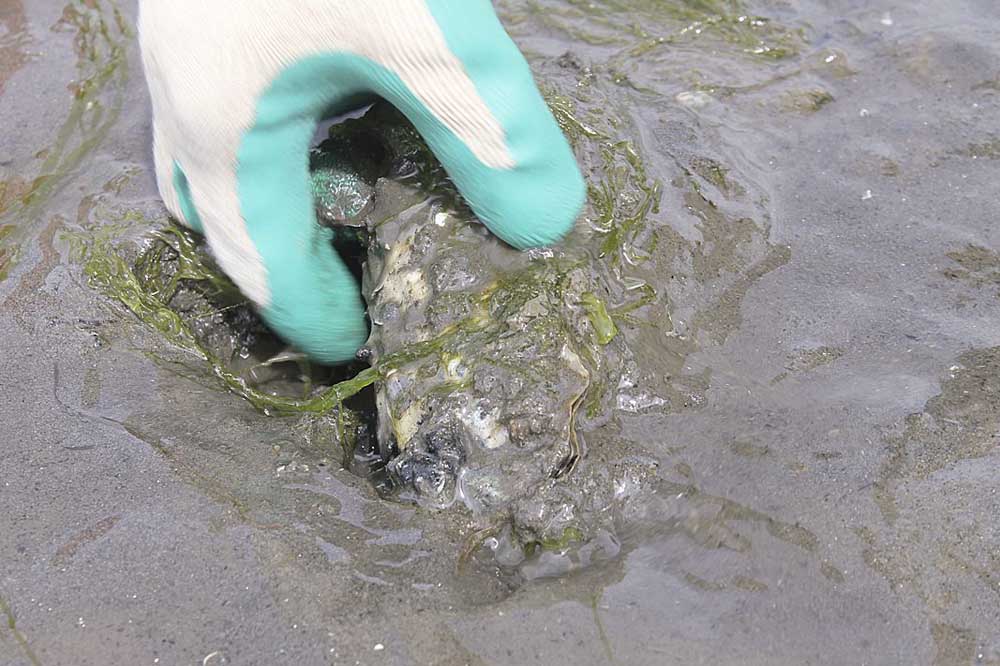Shellfish farmers lick wounds, hire PR help
Published 5:22 am Wednesday, June 17, 2015

- Willapa Bay shellfish farmer Brian Sheldon pulls a sinking oyster out of mud made soft by burrowing shrimp May 11. Growers have dropped a state-approved plan to spray tidelands with a pesticide to immobilize the shrimp.
OYSTERVILLE, Wash. — Third-generation shellfish farmer Brian Sheldon walked onto Willapa Bay at low tide and showed where he had planned to spray in May and seed with coin-sized oysters in July.
Because of negative public reaction, he and fellow growers won’t spray for burrowing shrimp, an aptly named creature that tosses mud to the surface while churning firm tidelands into goo.
Sheldon said that if he went ahead and put down tiny oysters on this shrimp-riddled 30-acre section, they’d be buried and dead by October. There goes, potentially, 25,000 gallons of oysters, at, say, $24 a gallon.
“It’s hard to watch ground like this go to hell and not be able to do anything about it,” Sheldon said.
Sheldon and other oyster and clam growers in Willapa Bay and Grays Harbor on Washington’s southwest coast are regrouping after abruptly withdrawing plans to spay up to 2,000 acres of tidelands with imidacloprid, a neonicotinoid pesticide.
The Washington Department of Ecology issued the permit April 16 and public outrage followed.
Shellfish growers know applying pesticides in tidelands is controversial, but Sheldon said they underestimated the potential for backlash.
Getting DOE’s permission was tough, but the agency and growers were portrayed by critics as partners in environmental crime.
“I mean, wow! That’s unbelievable. I’m sure anybody in agriculture will know what I’m talking about,” Sheldon said.
The plan unraveled. Puget Sound-based Taylor Shellfish Farms, the country’s largest producer of Manilla clams and geoducks, announced May 1 it would not spray its Willapa Bay beds. The company defended the spraying and acknowledged breaking ranks would affect other growers, but stated it was respecting consumer wishes.
“Our priority is to maintain our longstanding relationship with these customers,” according to a company statement.
Two days later, the Willapa-Grays Harbor Oyster Growers Association told DOE it was giving up the permit. “We felt at the time, it was the best decision we could make. Things were just spiraling out of control,” Sheldon said. “We felt like we had to take a hit and step back.”
Since then, the association has hired a public relations firm to help it respond to criticism.
“What really got us was the social media,” said Willapa Bay shellfish grower Ken Wiegardt, a fifth-generation farmer.
Sheldon said growers are “in a state of shock” over the events. He said he had actually hoped growers would be perceived as being responsive to environmental concerns by using imidacloprid.
Imidacloprid was to replace carbaryl, an older insecticide, the use of which has resulted in lawsuits and increasing regulations and that the Willapa Bay and Grays Harbor shellfish industry agreed to phase out more than a decade ago.
Imidacloprid is widely used on land crops. The U.S. Environmental Protection Agency and Washington State Department of Agriculture approved using it specifically in the bay and harbor.
Shellfish growers were to apply 1/16th as much imidacloprid per acre as they did carbaryl, which was used between 1963 and 2013.
Imidacloprid wasn’t going to be as lethal to burrowing shrimp, but growers said they would be more precise about when and where they sprayed.
The U.S. Fish and Wildlife Service and National Oceanic and Atmospheric Administration recommended DOE deny the permit, arguing that field trials in the bay had not yet conclusively determined that imidacloprid would not be detrimental.
Nevertheless, DOE concluded there would be no significant unavoidable adverse impacts, including to bees that pollinate the peninsula’s cranberry bogs, among other plants. As a condition to issuing the permit, DOE demanded monitoring of the pesticide’s effects.
With no current permit to spray for burrowing shrimp, it’s unclear what’s next for shellfish growers.
Washington State University research scientist Kim Patten has spent more than a decade studying how to control burrowing shrimp and hasn’t found a practical alternative to pesticides.
Going back to carbaryl isn’t an option. The EPA no longer registers it as an aquatic pesticide, and DOE has closed off any chance growers could revive their old permit to use it, DOE spokesman Chase Gallagher said.
Growers will miss at least one year of spraying, but they can’t let the matter drop for long, Sheldon said.
“This is not an abandonment of this (spraying) program,” he said. “We’re going to try to do a better job of getting the truth out.”




